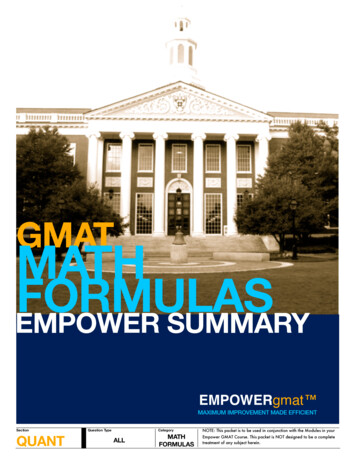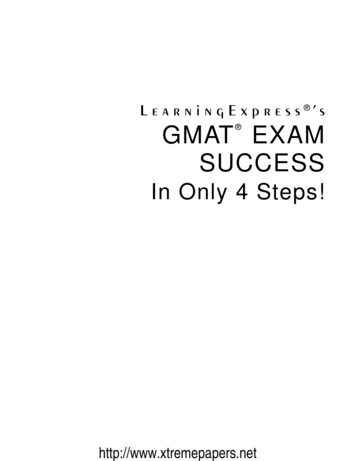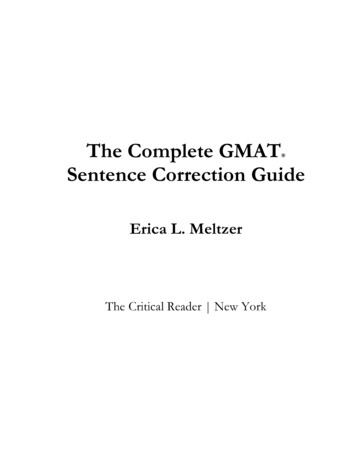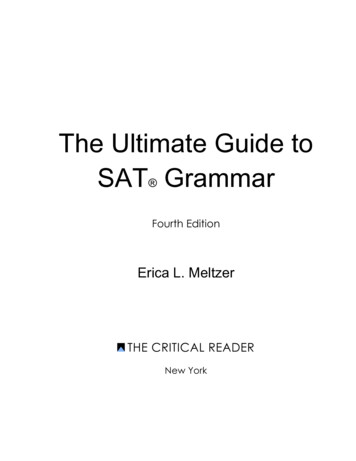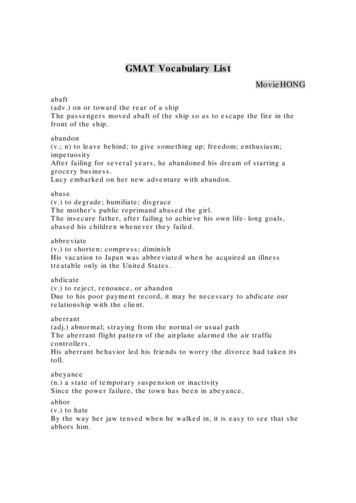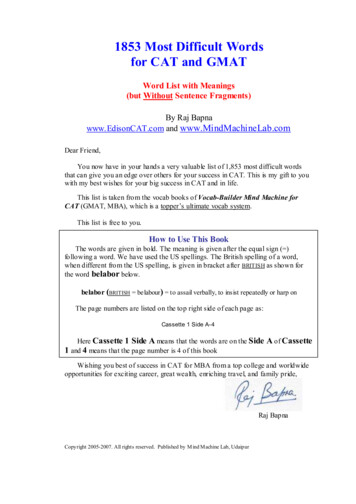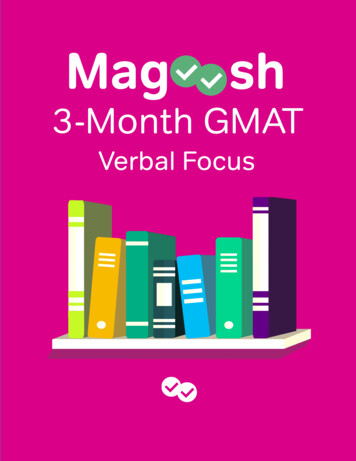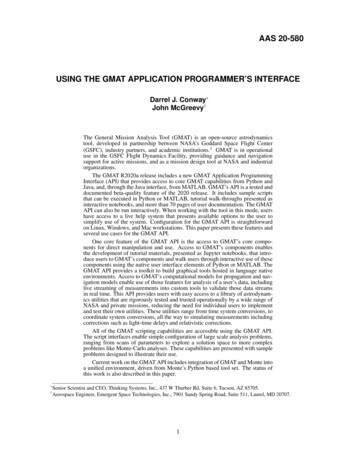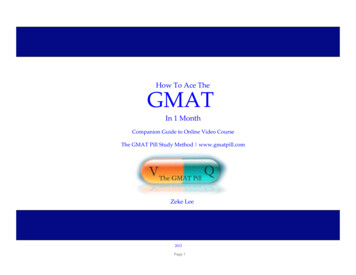
Transcription
How To Ace TheGMATIn 1 MonthCompanion Guide to Online Video CourseThe GMAT Pill Study Method www.gmatpill.comZeke Lee2012Page 1
Table of ContentsChapter 1: Getting Into the Right Mindset for GMATHow To Prepare For GMAT In 1 MonthSyllabus: Detailed 5-day Plan For Each SectionGMAT Test Dates And RegistrationWhere Your 250 Fee GoesWhen To Take The GMAT And Why Earlier Is Usually BetterThe 1 GMAT Strategy You Need To KnowGMAT Psychology And Timing StrategiesVisualize SuccessHow To “Do” GMAT QuestionsGetting Into A Top Business SchoolGMAT: Management Consulting & Investment BankingGMAT VS SATGMAT Gets Popular With European Schools45678912141619262931Chapter 2: Verbal: Sentence CorrectionQuestionsAnswer KeySample Frameworks33344243Chapter 3: Verbal: Critical ReasoningQuestionsAnswer KeyChapter 4: Verbal: Reading ComprehensionI. Reading the PassageII How to Approach RC Questions.III. Standard Question TypesIV Key Take Aways4849565859606672Page 2
Table of ContentsChapter 5: Official Guide 12th EditionCategorization of Quant Questions By type8889Chapter 6: Quant Problem SolvingQuestionsAnswer KeyFormulas and Diagrams9091104105Chapter 7: Data SufficiencyQuestionsAnswer Key125126133Back Cover135Page 3
Getting Into the Right Mindset for GMATDays 7-12: Log in to GMAT Pill and go through your nextweakest section.How To Prepare For GMAT In 1 MonthDays 12-15: Start your 3rd weakest area (e.g., DataSufficiency)Days 16-19: Start your 4th weakest area while also doingpractice problems forother sections that already covered.Days 20-22: Retake the same exam that you took on Day 1with the mentalitythat you should get everything correct (after all, you’ve seenthe questionsbefore!Days 20-22: Retake the same exam that you took on Day1 with the mentality that you should get everything correct(after all, you’ve seen the questions before!)Day 1: Download the GMAT Prep Software fromMBA.com and take a test tobecome familiar with the directions/logistics and identifywhere you need helpmost.Days 23-24: Review any questions that you got wrong.Days 2-6: Log in to GMAT Pill. Watch and absorb theefficient thought processesand concepts for your weakest section (e.g. SentenceCorrection). Spend at least3 solid straight hours on Day 2.Days 26-31: Take practice exams in the Official Guide. Atleast one full day on a weekend should be dedicated tosimulating exam conditions. If your exam begins at 9am,make sure you practice waking up at 7am and goingthrough your pre-exam routine. Control your nerves and getpsyched.Day 25: Relax. Mentally prepare for the set of practiceexams on the Official Guide you are about to take. Reviewvideos in the GMAT Pill.Days 32-33: Exam DayPage 4
Getting Into the Right Mindset for GMAT8:30-9:30pm: Redo ALL the 600 and 700 level questions inthe GMAT Pill, pausing each video. Again, you SHOULD beable to get ALL of these correct. After all, you’ve alreadyseen these questions before!Syllabus: Detailed 5-day Plan for each section(SC/CR/DS/PS)We say “5-day Plan” but realistically we know most ofyou will not study 5 days in a row straight. So this is planmight span out over 7-10 days assuming you take a dayor two to rest during this time. These 5 days are the daysthat you dedicate to studying for SC.Day 3-6 (Monday-Wednesday) 10pm-11pm before yougo to bed: Go through at least 10 questions each day.This should take you 30 minutes. Additionally, Go throughthe set of 10 questions that you went through the previousday–with the mentality that you should get all of themcorrect. This should take you 20 minutes as you budget 2minutes per question. Refer back to GMAT Pill videos forthought process.Day 1 (Saturday) 10am: Dedicate 2 hours to focus onthe 10 Core Framework videos. Rewind and forwardaccording to how comfortable you are with the material.Noon-1pm: Get Lunch1:30pm – 4:30: Dedicate 3 hours to 600 Level Questions.Pause each video and try to answer the questionyourself. Then hit the play button and see how yourthought process compares to mine.Day 2 (Sunday): 11am-noon: browse through the 10Core Frameworks again, spending more time on thevideos you are less familiar with.1:30pm-3:30pm: Start looking at some practice questionsin the Official Guide. Mark the ones you get wrong on thefirst try. Review the explanations for the ones you getwrong3:30-4:30: Redo ALL of the practice questions you justwent through with the mentality that you SHOULD beable to get ALL of them correct. After all, the ones yougot wrong you already saw the explanation!Page 5
Getting Into the Right Mindset for GMATcenters are not open on wkends, though you mayoccasionally find a Saturday here or there that could beopen.Browse the test center list before you actually register here.GMAT Test Dates And RegistrationWhen Do I Take the GMAT? When are the GMAT TestDates?It’s not like the SATs where everybody takes the exam atone time. You sign up to take theexam INDIVIDUALLY, whenever you are free. Yes, that’sright. The only thing to consideris when the test center (whichever test center you wantto go, preferably close to where youlive) is open.How much does the GMAT cost? GRE Cost? 250 to register for the GMAT exam. 50 to reschedulebefore 7 days of exam.Why should I take the GMAT now?Well, your GMAT test score is valid for 5 Years. Five yearsis a long time. So even if you arejust out of college, it might make sense to take the examnow while you are still in study mode.How Do I Register for the GMAT?You must create an account withMBA.com, then proceed through the steps to choose atesting center and available time. Once you do that, youmake your 250 payment and you’llhave officially registered for the GMAT exam.Additionally, it is very stressful studying for the exam whileworking full time so the best way to avoid this is to take thetest when you have a break.But, BEFORE YOU REGISTER, you should browsearound the available test centers in your area and seegenerally when they would be free. Your GMAT TestDate will be determined by when your closest test centeris available and reserving that date. You shouldschedule at least a month in advance to make sure thattime slot is open. Also, it’s good to know that most testPage 6
Getting Into the Right Mindset for GMATtest takers answer them. The new questions they create arerandomly used as “experimental” questions that you see onyour test.Where Your 250 GMAT Fee GoesThe ATGSB was later renamed the Graduate ManagementAdmission Test (GMAT) in 1976. At first only 2000 peopletook the test each year way back in 1953. But now about250,000 people take the test annually.So there you go. A quick history lesson on the GMAT.The GMAC recently released data on the different testtakers categorized by age group. Take a look where you fitin and who your competition is. Notice the growth rate of testtakers under the age of 24 is higher than that of the otherage groups.The entity you pay money to is the GraduateManagement Admission Council (GMAT), which is aninternational non-profit association of business schoolsthat “do business” with business schools and institutions.Basically this is what happened. In 1953, a group off 9business schools got together and said they were gettingapplications from people so diverse it was difficult toassess which ones were quality and which ones weren’t.So they put together a standardized test that was initiallyknown as the Admission Test for Graduate Study inBusiness (ATGSB).The ATGSB basically went around to business schoolsand academic institutions throughout the world and said:“Hey we got this test called the ATGSB that we thinkwill help you assess MBA applicants. How aboutthis.you give us money and we’ll test your students foryou and send you their scores. We’ll even give you lotsof fancy statistics including mean, median, standarddeviation, and everything else.”And so a (non-profit) partnership was formed. Prettyinteresting, huh.So your fees go to this organization that makes up testquestions and develops a database to track all thestatistical characteristics of each question based on howPage 7
Getting Into the Right Mindset for GMATI am not in college anymore and I missed my chance totake the GMAT during this time. What do I do now?Don’t worry. Thousands of people are in your shoes. Youmight not be used to the pressures of test taking so will needto pay extra attention to doing several practice examsmimicking exam-like conditions.When To Take The GMAT And Why Earlier Is UsuallyBetterWhen is the GMAT?There is no set date (like there is for the SAT) that youmust take the GMAT. So you have the liberty ofscheduling a date and time for your testing at the nearesttesting administration site.What do you mean by exam-like conditions?I mean instead of just running through questions on apractice exam bit by bit, you should schedule an entiremorning or afternoon to take the exam with a timer.Especially with the Computer Adaptive Test (CAT) format ofthe exam, you should take these practice exams AS IF itwere the real thing, at least several days before your realexam and preferably earlier.Sounds good. Since I can choose when to take theexam, when is the best time to do so?Perhaps the best time to take your GMAT is while youare still in school, or shortly afterwards. Remember, asyou gain more real world experience, you lose the testtaking intuition that you used to have when you were inschool. Taking an intensive test like the GMAT 5 yearsafter your last rigorous exam can be quite challenging.Test-taking intricacies like operating in a time pressuredenvironment, reading through answer choices, markinganswers, and dealing with psychological issues aresecond nature to you when you are in school, but theybecome quite unfamiliar the longer you wait after college.You want to minimize this risk by taking the exam duringthe summer after graduation or the summer betweenyour junior and senior year–this is the ideal time.Remember, the GMAT exam is valid for 5 years. If youhave any intention of applying for business schoolsometime in the next 5 years, you should take it at yourearliest convenience.What else should I take into account?If you are considering the GMAT, chances are you have abusy life. When applying to business school, you will need todedicate time not only to your job, but also anyextracurricular activities or initiatives you are pursuing. Partof an organization that holds ambitious yearly events? Putsome time and effort and participate on the board in aleadership position. Itching for a promotion at your job soyou can mention it in your Bschool application? You’ll needto put in the time and effort. You’ll also need to budget timefor researching/visiting schools and writing those dreadedessays. And of course, you want a social life and time withyour family. The GMAT is the LAST thing you want to worryabout when juggling all these things. That’s why it is best toget it out of the way.Page 8
Getting Into the Right Mindset for GMATShould I study first and then schedule the exam orschedule the exam and then study?This is a personal preference. I would recommend you toschedule the exam a few months in advance when youintend to take it. Pay the 250 (yes, not cheap) it costs totake the exam so that you are invested into the exam–forcing you to study. Otherwise, if you casually study forthe exam, you may never progress anywhere.The 1 GMAT Strategy You Need To KnowMany GMAT students mistakenly believe that focusingtheir study on math is the best strategy to raising theirGMAT score.Sure, if you have a known weakness in math you’ll need tobrush up on your math skills and logic. And yes, the GMATmath is significantly more difficult than the SAT math (moreemphais on logic and structuring the problem rather than onpure calculation).But at the end of the day, doing well on the VERBAL sectionis more important to your overall score than if you didequally well on the MATH section–this is ESPECIALLY truein the 700 range. If you are targeting this score range, youMUST polish up your verbal section.Don’t believe me? Let’s look at some data focusing on thehighest levels of scoring: 700 rangeIf you score 99th percentile in Verbal (49V), and yourQuant score is 39M 57th percentile Total (730, 96th percentile)41M 63th percentile Total (730, 96th percentile)43M 70th percentile Total (740, 97th percentile)Notice it does not matter how many extra points this studentcan get on quant. In the end, her score is around the samePage 9
Getting Into the Right Mindset for GMATLet me say that again:Doing well in Quant is good, but not as good asdoing well in Verbal!This is almost ridiculous! A high quant score and averageverbal score yields a LOWER score than a high verbalscore and an average quant score!Indeed, the GMAT is biased towards success on theverbal section!!Why would the GMAT creators do this?score of 730 whether her math score is 39 or 43. Doingwell in Verbal pays off!My best guess is one of supply and demand (ah yes,how relevant to an exam for business school). The influxof non-native English speakers from internationalcountries who are strong in quant but weak in verbal andjust the plain fact there are more people that are great atquant (where there is always a correct answer) than thenumer of people who are familiar with the idiomaticintricacies of the English language and inductivereasoning.Now is the opposite true? What if a student scoresoutrageously well in Quant but average in Verbal?If you score 99th percentile in Math (51V), and yourVerbal score is 30V 57th percentile Total (670, 85th percentile)32V 65th percentile Total (690, 88th percentile)34V 70th percentile Total (710, 92nd percentile)But whatever the TRUE reason is, it does NOT matter.What does matter is what this bias in the GMAT meansto you. If your verbal abilities are not strong, then youMUST improve them.Notice doing extremely well in quant does not guaranteeyou a good score. In fact, an average score in the 57thperce
Days 7-12: Log in to GMAT Pill and go through your next weakest section. Days 12-15: Start your 3rd weakest area (e.g., Data Sufficiency) Days 16-19: Start your 4th weakest area while also doing practice problems for. other sections that already covered. Days 20-22: Retake the same exam that you took on Day 1 with the mentality. that you should get everything correct (after all, you’ve seen .

